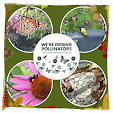 |
| Click on Image to Enlarge Meme Credit - Simple Organic Life |
"Weeds," said Robert Fulghum, "are plants growing where people don't want them. In other words," continued the author of All I Really Need to Know I Learned in Kindergarten, "weeds are in the eye of the beholder ... dandelions are NOT WEEDS - they are FLOWERS!"
I like Fulghum's style. I'm quite partial to the delightful dandelion, myself, and have been since I was a little girl. Sunny and bright in the springtime, I've long admired the dandelion's ability to grant wishes when blown to the wind, and remember well the jewelry and hair adornments I used to make from them.
Contrary to the long held belief that dandelions are a scourge to lawn and garden and a noxious weed to be eradicated at all cost, the flower of the dandelion should be celebrated as one of the first available sources of food for bees and other pollinating insects in the spring.
It’s truly unfortunate that the modest dandelion’s astonishing ability to self-seed and its deep burrowing taproot invites definition as invasive weed when in fact they are a flower. Perennial and herbaceous, the dent de lion or tooth of the lion, has many beneficial qualities that should render even the fussiest of grass growers silent about dandelion eradication.
Specifically, the dandelion is an edible green, an immune system and hormone enhancer, and a source of important vitamins A, C, and K; iron, manganese, potassium, calcium; and antioxidants. Every part of the Dandelion is edible, although care should be taken when sensitive or allergic to latex or inulin or taking blood sugar modulators.
Otherwise, dandelion greens and stems are extremely nutritious in salads and spreads, the flowers can be cooked or eaten raw or blended with citrus to make a praise-worthy wine, and roasting the stems produces a dandelion coffee substitute that is caffeine-free.
Add to all that, the fact that pollinators depend on the dandelion pollen for sustenance until other flowering perennials come into bloom, and you have some pretty substantial reasons to leave the sunshiny-yellow dandelion’s alone.
If, however, you still feel compelled to rid your lawn or garden of dandelions, at least resist using harmful pesticides and chemicals. Chose instead to carefully dig the dandelions out, only after the colourful blooms have faded to give pollinators a chance to feed on the life-sustaining nectar. Better still, pick the seeds to prevent too much spread, and welcome the healthful herb-like greenery to your garden as you would parsley or kale.
The University of Rochester boasts the dandelion as their official flower, and Dandelion Yellow an official school colour.” They’ve even celebrated the flower oft' condemned as a lowly weed in this linked song, The Dandelion Yellow, sung by the Yellow Jackets and written by Richard L. Greene and Charles F. Cole.
So, here's to the spirit of celebrating the pretty yellow dandelion and its important role in providing pollinator sustenance. Giving dandelions a place to grow and pollinating insects a better chance at survival will benefit us all in many unexpected ways!
